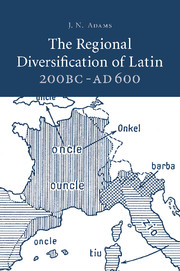Book contents
- Frontmatter
- Contents
- List of maps
- Preface
- List of abbreviations
- Chapter I Introduction
- Chapter II The Republic: inscriptions
- Chapter III Explicit evidence for regional variation: the Republic
- Chapter IV Explicit evidence: the Empire
- Chapter V Regionalisms in provincial texts: Gaul
- Chapter VI Spain
- Chapter VII Italy
- Chapter VIII Africa
- Chapter IX Britain
- Chapter X Inscriptions
- Chapter XI Conclusion
- Maps
- Bibliography
- Index verborum
- Subject index
- Index locorum
Chapter V - Regionalisms in provincial texts: Gaul
Published online by Cambridge University Press: 22 September 2009
- Frontmatter
- Contents
- List of maps
- Preface
- List of abbreviations
- Chapter I Introduction
- Chapter II The Republic: inscriptions
- Chapter III Explicit evidence for regional variation: the Republic
- Chapter IV Explicit evidence: the Empire
- Chapter V Regionalisms in provincial texts: Gaul
- Chapter VI Spain
- Chapter VII Italy
- Chapter VIII Africa
- Chapter IX Britain
- Chapter X Inscriptions
- Chapter XI Conclusion
- Maps
- Bibliography
- Index verborum
- Subject index
- Index locorum
Summary
INTRODUCTION: SOME POINTS OF METHODOLOGY
Sometimes a text or inscription contains without comment a usage that there is reason to assign to a region. Its regional character may be deducible from various types of evidence. First, it may be discussed as a regionalism by another writer. Second, its distribution in extant Latin may suggest that it was localised. Third, in the Romance languages its reflexes may have a restricted distribution corresponding to its distribution in Latin texts. Sometimes the origin of the writer of the text may be known: if a usage associated with Gaul is found in a text written by someone known to have been Gallic it may be obvious that the writer had picked it up in his patria. If on the other hand there is no external evidence for the writer's origin, the usage, or, better, a cluster of such usages, may suggest either that he was a native of a certain area, or that he wrote the text in that area and drew on the local variety of the language.
But this is an idealised picture. It has in practice proved difficult to pin down the geographical origin of late texts. E. Löfstedt made the point thus (1959: 42): ‘To assign any text to a particular province on linguistic grounds has in most cases been found impossible, and at the best is extremely difficult.’
- Type
- Chapter
- Information
- The Regional Diversification of Latin 200 BC - AD 600 , pp. 276 - 369Publisher: Cambridge University PressPrint publication year: 2007



